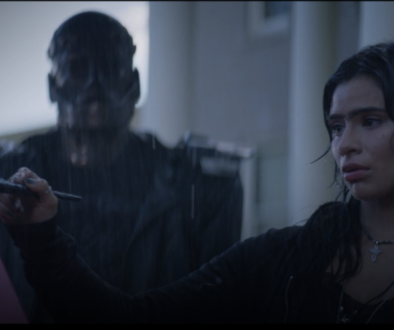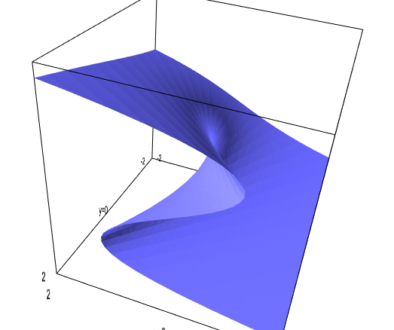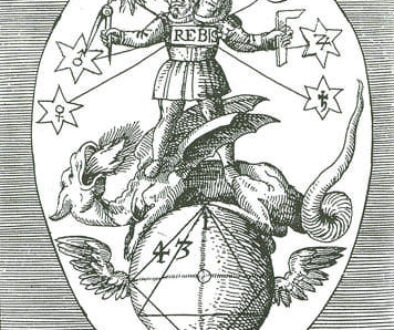This is the first of ten parts of Chapter Five of The Last War in Albion, covering Alan Moore’s work on Future Shocks for 2000 AD from 1980 to 1983. An ebook omnibus of all ten parts, sans images, is available in ebook form from Amazon, Amazon UK, and Smashwords for $2.99. If you enjoy the project, please consider buying a copy of the omnibus to help ensure its continuation
Most of the comics discussed in this chapter are collected in The Complete Alan Moore Future Shocks.
PREVIOUSLY IN THE LAST WAR IN ALBION: Shortly after getting his first work in Doctor Who Weekly, Alan Moore sold the first of several short stories he would write for IPC’s 2000 AD, an iconic sci-fi magazine created by Pat Mills and John Wagner, who got their start at IPC creating Battle Picture Weekly in 1975.
“The client’s head, contained inside the sack, came free with a loud smack where the spine parted company with the skull.” – Warren Ellis, Dead Pig Collector
 |
Figure 190: The first issue of Pat Mills’s
controversial classic Action. |
Battle Picture Weekly was an unambiguous success, much to the chagrin of Le Grand and the old guard (although this may have had as much to do with Pat Mills’s impressive pay package, which exceeded that of John Sanders, who hired him as it did with any actual creative differences). Appropriately, Mills and Wagner quickly found more work within IPC. Wagner was tapped to lead an only semi-successful revamp of Valiant, an old adventure magazine that was, despite Wagner’s efforts, merged into Battle in 1976. Mills, on the other hand, was tasked with creating another book that would go even further in the direction pioneered by Warlord and Battle Picture Weekly, to be called Action, and debuting in February of 1976.
British comics were by and large a working class medium, as Alan Moore has observed, but Action was unusual in targeting the working class population directly and fully indulging the working class, anti-authority attitudes of The Bootneck Boy. Its famed centerpiece was Hook Jaw, which was ostensibly a Jaws knockoff. Featuring a giant shark named, fittingly enough, Hook Jaw, the strip inverted the Jaws formula – where Spielberg reveled in keeping the shark off-screen for as long as possible and building up suspense, Hook Jaw puts the giant shark in the first panel, and proceeds to revel gratuitously in its violence. But for all the strip’s glorious violence, Mills was insistent that it be an “ecological” story in which Hook Jaw is the protagonist, who would take bloody vengeance against evil and corrupt humans on behalf of the untamed nature he represents. This was central to Action’s appeal and logic – it was not merely a comic about reveling against gratuitous violence, but one about reveling in gratuitous violence against authority figures.
 |
Figure 191: Hook Jaw was deliberately given the center
position in Action so that it could get color pages and use
ostentatious quantities of red ink. (Writer and artist
uncredited, Action #7, 1976) |
In this regard the most iconoclastic story in its first issue was perhaps Hellman of Hammer Force, which took as its protagonist a German tank commander in World War II. Hellman, however, was an honorable soldier who clashed repeatedly with the Nazi hierarchy, having little love for Hitler and insisting that he’s “a soldier, not a butcher.” The story thus presents a bizarre inversion of standard war comics in which the reader is asked to root for a German soldier fighting the British, but where the underlying moral judgments of what good and evil are remain consistent.
 |
Figure 192: Action asks probing questions about elephant
teeth and provides much-needed catharsis regarding Tony
Blackburn. |
The anti-authority tendencies exemplified by this sort of story were on full display throughout the rest of the magazine. A regular feature was Twit of the Week, in which readers could propose various celebrities to be deemed twits for their annoying excesses. And so beloved icons like Bruce Forsyth (a reader “can’t bear his catch-phrases”), Kojak (“he’s always sucking a lolly”), and Lee Majors (“Bionic Berk”) are roundly mocked. On the same page the comic would feature banal facts akin to the later Fantastic Facts series in Doctor Who Weekly, only with someone asking “So What?” in response to empty trivial like “Irishmen in the 9th century used to pay a ‘Nose Tax’ to the Danes,” such that the feature became about mocking the stupid filler of other magazines.
 |
Figure 193: An “appalling and brainless” image, at least
according to Football League secretary Alan Hardaker
(Written by Tom Tully, artist uncredited, Action #32, 1976) |
Later issues of Action introduced strips like Look Out for Lefty, a football strip penned by Tom Tully that focused on a working class hothead, Kenny “Lefty” Lampton, and his travails on and off the pitch. It was the sort of football strip where the protagonist’s girlfriend might take revenge on a player who’s deliberately sabotaging Lefty’s game so as to keep him in the reserves by throwing a Coke bottle at his head. The effect of this was a piece in the Daily Mail, which included Football League secretary proclaiming that “it is really appalling that there are people so brainless as to sell comics to children with stuff like this inside them. The man responsible ought to be hit over the head with a bottle himself,” while other supposed experts called for a program of bannings akin to the Frederic Wertham-inspired American censorship of the 1950s and compared the comic to pornography.
 |
Figure 194: One of the many prominent
and influential Daily Mail fans. |
This was, of course, more or less exactly the response Action was going for, and almost everyone involved with the comic would have worn their condemnation in The Daily Mail – a staggeringly reactionary paper that memorably ran a front-page headline in July of 1934 proclaiming “Hurrah for the Blackshirts” and speaking enthusiastically about how Oswald Mosley, founder of the British Union of Fascists, had a “sound, commonsense, Conservative doctrine” (an editorial stance that had, a few months earlier, earned editor Harold Harmsworth, Lord Rothermere, a fan letter from Adolf Hitler thanking him for his “wise and beneficial public support” of “a policy that we all hope will contribute to the enduring pacification of Europe”), and which, more recently, lambasted Neil Gaiman’s wife Amanda Palmer for a moment during her Glastonbury performance where her left nipple was visible, to which Palmer wrote and performed a scathing musical response in which she called them a “misogynistic pile of twats” shortly after ripping off her kimono and exposing the bulk of her naked body to a rapturous round of applause from her audience – as a badge of honor.
 |
Figure 195: Key elements of Kids Rule OK‘s formula
were the choice of adults to kill at the outset (a judge,
a cop, and a teacher) and the gruesome corpses they leave.
(Writer and artist uncredited, Action #31, 1976) |
Such criticism, however, eventually had its effect. The Daily Mail’s criticism was echoed by the Evening Standard and by The Sun, which proclaimed the magazine to be “The Sevenpenny Nightmare,” and who trotted out Ted Willis, creator of Dixon of Dock Green, and Mary Whitehouse to condemn it. Of particular concern was Kids Rule OK, a strip debuting in issue #31 of Action. The premise of Kids Rule OK is that increased pollution has caused adults to suddenly drop dead and immediately turn to dust, leaving only people below the age of twenty alive. “As we die,” a medical expert explains, “the children grow contemptuous of us. Law and order is breaking down. Soon, civilisation, as we know it, will be in ruins,” before promptly dropping dead himself. The resulting story was basically a festival of teenage gangs imaginatively killing each other, and its attitude was well captured by the cover to Action #32, which featured a rioting group of kids led by a boy whipping a fallen adult with a chain, a policeman’s helmet on the ground beside him, suggesting clearly the occupation of the victim. The caption, “Aggro! is a way of life in Kids Rule OK,” went well with the captions along the top of the cover such as “Wow! Blood flows as Green fights on!” and “Wow! Disembowelled by Hook Jaw!”
 |
Figure 196: Action was unabashed in its anti-
authority leanings, an attitude exemplified in
Kids Rule OK (Artist uncredited, Action #32,
1976) |
The pressure quickly grew to be too much, however. Before long a direct action group called Delegates Opposing Violent Education was going around and defacing newsstand copies of Action with stickers that proclaimed, “CAUTION. This is a BLACKED publication. Certain writings in this work are not cleared by DOVE as being pro-child, in that they are either by direct meaning, context or by implication, an incitement for adults to breach the primary FUNDAMENTAL written principles of the Children & Young Persons Act 1933 Section 1 (1) which clearly prohibits: ‘Assault. ill-treatment, abandonment. neglect and/or mental derangement’ of the child to age 16. In the interests of Free Speech this publication remains undamaged. DIRECT ACTION by DOVE. Totnes, Devon. ‘On the side of the child only – Britain’s Future’.” A few weeks after the debut of Kids Rule OK the BBC had John Sanders on Nationwide, its evening news magazine program, where he was brutally grilled by presenter Frank Bough, who went off the pre-discussed format to condemn Action. Shortly thereafter the magazine was the subject of debate in the House of Commons. When W H Smith reportedly threatened to drop all IPC titles from its stores if Action was not taken off the shelves, Jack Le Grand, with Sanders on vacation in Italy, took the opportunity to order the October 23rd, 1976 issue pulped, and the magazine vanished for six weeks before returning in a neutered form, with Kids Rule OK simply vanishing from its pages, along with most of the graphic violence and, for that matter, point of the comic. The magazine limped on for another year before it was finally put out of its misery.
 |
Figure 197: Shako is notable for being the
only bear on the CIA Death List (Written
by John Wagner, art by Dodderio, 2000 AD
#24, 1977) |
For all that Action ended ignobly, however, it was still a sales success, and Mills quickly found himself tasked with a new job – developing a science fiction comic to take advantage of the growing popularity of science fiction films spearheaded by Star Wars. That magazine had been kicking around IPC offices for a while due to a memo by a staffer named Kelvin Gosnell that was initially ignored (by Jack Le Grand, of course), but finally picked up on by Sanders. Mills quickly hit on the idea of using a revival of Dan Dare, late of Eagle and still owned by IPC, as a flagship strip, and set about coming up with a variety of other strips to accompany it. In August of 1976, two months before Action imploded, Mills presented IPC management with a dummy issue of the magazine featuring unlettered art from six strips, only four of which survived (in altered forms) to the first issue six months later. Two others – The Visible Man (a rather grotesque strip about a man whose skin becomes transparent) and Shako (a fairly straightforward clone of Hook Jaw featuring a polar bear instead of a shark) would be held to fill gaps later in the magazine’s run, so when the magazine actually debuted it had a total of five strips.
 |
Figure 198: Bill Savage, hero of the lead strip
in the first 2000 AD, sets a clear tone for the
magazine (Written by Pat Mills, art by Jesus
Blasco, 2000 AD #1, 1977) |
The four surviving strips included the revamped Dan Dare (which never really worked or fit in 2000 AD, and was finally abandoned after two years), the fairly forgettable M.A.C.H. 1 (a Six Million Dollar Man knock-off), and Harlem Heroes (a futuristic sports strip notable only for its early art by Dave Gibbons, who credits his getting the gig over the numerous other artists who were tried on the strip for his familiarity with US comics and the fact that he “gave the Harlem Heroes a sort of American superhero costume”). None were particularly landmark. The fourth, however, was rather more promising. Called Invasion, it kicked off the first issue of 2000 AD with a stunning splash page by Jesus Blasco of Volgan paratroopers invading Great Britain. The Volgans were, in practice, thinly veiled Russians, and the invasion itself lasts all of four pages before the swarming troops overrun the country and establish martial law. The strip is firmly in the tradition of Action, complete with giddily excessive violence – the fifth page has a thinly veiled Margaret Thatcher being executed on the steps of St. Paul’s Cathedral – and a working class rebel of a hero, Bill Savage, who discovers that a Volgan tank blew up his house and killed his family. “There’s nothing left,” his friend exclaims, to which Savage laconically points out that he’s got “one thing left… me shotgun!” and promptly uses it to gun down a Volgan patrol. “You’re crazy, Savage!” his friend implores him. “You can’t fight the Volgs alone. Britain’s surrendered! The war is over!” To which Savage replies, “I’m opening it again – my war’s just begun!!” And indeed, the strip features exactly that – Savage, armed only with a shotgun and working class grit, proceeds to organize the resistance and lead the takeback of his country.
 |
Figure 199: Judge Dredd as originally envisioned
by co-creator Carlos Ezquerra. |
The fifth strip in the first issue, on the other hand, was added after the dummy issue. Titled Flesh, it told the story of time-travelling hunters who go back in time to kill dinosaurs, and of Old One Eye, the terrifying dinosaur who marauded the main characters. Combining the over the top gore of Hook Jaw with a high concept premise and a visual aesthetic drawn from Western films, Flesh was unapologetically lurid, using its sci-fi premise to mash up a ridiculous mismatch of concepts and imagery into an attractively weird package. But it was not until the second issue of 2000 AD that its true starring strip, the one that would encapsulate its aesthetic and approach, debuted. That strip was Judge Dredd, created by Mills and Wagner alongside artist Carlos Ezquerra, and it would prove to be one of the most enduring creations of British comics.
Judge Dredd’s success is in many ways down to its peculiar inversion of the established formula Mills and Wagner pioneered back in The Bootneck Boy. Aware of the growing criticism of Action, Mills and Wagner designed Judge Dredd to be able to deflect the usual line of argument against the magazine. And so instead of anti-authority violence of the style of Kids Rule OK, Judge Dredd featured massive amounts of violence committed by a futuristic police officer against criminals. This was couched in the outlandish world of Mega-City One, a futuristic city sprawling across the entire American eastern seaboard in which vast city blocks, typically named after 20th century celebrities and television characters, would often feud and go to war with one another. (So, for instance, in the famed 1981 Block Mania storyline, the Enid Blyton and Dan Tanna blocks went to war.)
But the heart of the strip’s appeal came in its combination of the anti-authority leanings of Kid Rule OK or Look Out For Lefty with the noble bad guy protagonist of Hellman of Hammer Force. Judge Dredd takes for granted that its audience would recognize that its protagonist was deeply unsympathetic. The standard set-up of a Judge Dredd story involves Dredd going to great lengths to bust some “creep” whose crime seems relatively minor. [continued]














January 9, 2014 @ 12:30 am
City block names are such an eclectic mess as to be a special pleasure of Judge Dredd. Giant Haystacks Block for example.
2000AD was a relief. I'd read a copy of Action and literally had nightmares for a week. Somehow the Sci-Fi setting was less scary.
January 9, 2014 @ 8:38 am
"the fifth page has a thinly veiled Margaret Thatcher being executed on the steps of St. Paul’s Cathedral"
Lady Shirley Brown, I think, is a not-veiled-at-all Shirley Williams. Looking at the word balloon, it looks like 'Brown' may have been pasted over the original surname.
January 9, 2014 @ 9:02 am
Not to be too contrary about Action, because I think the broad thrust of 'it was violent, it was neutered, it led to 2000AD' is right, but weekly British comics came and went and merged and mutated all the time – titles like 2000AD, the Beano and Doctor Who that just keep going are exceptions to the rule.
The broad arc of every single comic was that they'd start strong (or vanish instantly), then sales would slide and slide until cancellation. Action ran in 'neutered' form longer than it did before it was spayed, so the comic clearly didn't instantly collapse below viability because it had been neutered.
Yes, I suspect sales were buoyant when there was all that free advertising from the media outcry and fell when people stopped talking about it. But no publication 'limps on' for nearly fifty issues.
January 9, 2014 @ 11:07 am
Erm…couldn't think of any other thread to drop this into but while we're talking comics has anyone seen this? Marvel comics' Power Man and Iron Fist taking on a thinly disguised Doctor Who and the Daleks.
http://comicsalliance.com/bizarro-back-issues-power-man-and-iron-fist-battle-the-daleks-1982/
January 9, 2014 @ 12:22 pm
There is something about "Fictional violence is bad, we should inflict real violence on its perpertators" that is almost admirable in its honesty, directness and complete lack of anything remotely resembling self-awareness.
My favourite block name will always be that Dredd himself – the Dirty Harry of the future – lives in Rowdy Yates Block.
January 9, 2014 @ 12:50 pm
British Comics were an ecosystem of sorts: survival of the popular. If they had anything at all worth keeping, they'd be consumed by another comic (X, now incorporating Y! in gradually smaller letters each week until the title of Y vanished) – I only got into The Eagle because, after 80 issues of MASK the title couldn't hold it's own and was incorporated into The Eagle.
20 Issues later and MASK was gone forever from The Eagle, but it was no bad thing – eventually I would have grown out of MASK anyway, but now I had Dan Dare, Charley's War, Doomlord and all sorts of other good stuff to mesmerise me…
January 9, 2014 @ 8:38 pm
Meanwhile, it seems that there has been a major escalation in the War:
http://slovobooks.wordpress.com/2014/01/09/last-alan-moore-interview/
January 9, 2014 @ 11:23 pm
It's reached the point in the war now that it feels like mummy and daddy arguing all the time. Is there no chance of them just hugging and making up? Think of the children!
Meanwhile, in a stunning display of synchronicity, there are a couple of new interviews featuring Grant Morrison on Chain Reaction: comedian (and occasional comic strip writer) Frankie Boyle with Morrison this week, and then Morrison himself interviewing musician and satirist Neil Innes next week. Innes, of course, is most famous for his imitation group the Rutles.
Link lasts for the next few days: http://www.bbc.co.uk/programmes/b006sf81
Of course, within The War, Alan Moore got there first: http://www.bbc.co.uk/programmes/b00lgkzc
Check out the archives, as there's some great stuff there (including Catherine Tate interviewing David Tennant).
January 10, 2014 @ 12:15 am
Indeed a classic.
The block names sum up the whole of Dredd – some are US film references, some are US political references and a whole bunch are references that only make sense in 1970s/80s British popular culture
January 11, 2014 @ 3:31 am
I'd heard about it. Who else now wishes we'd heard Matt Smith deliver the line, 'if you won't believe the evidence of your senses I can hardly expect you to take the word of a complete stranger.'